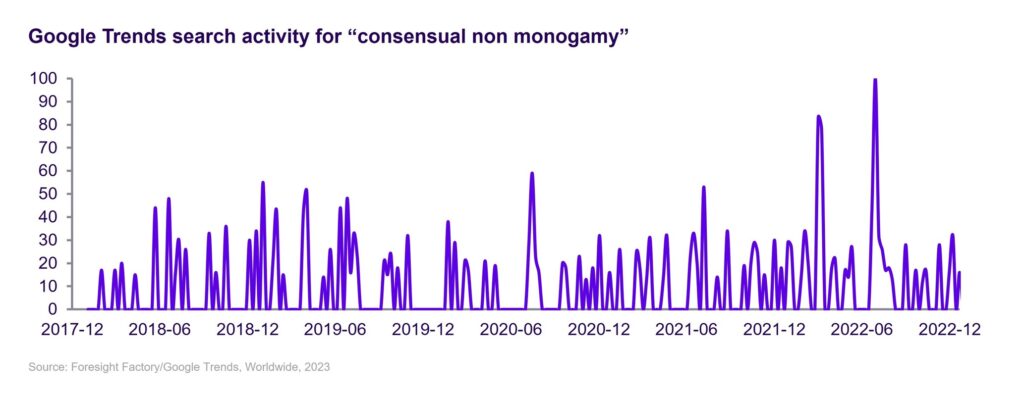In February, love is in the air, with Valentine’s Day a key feature of the month. How are relationships being redefined as norms shift and taboos are dispelled? And why is tinned tuna trending on TikTok, billed as the perfect date night treat? Plus, as tech layoffs continue, what does it say about the power balance between employers and employees?
Here are 3 consumer insights and behaviours that grabbed our attention in February, with actionable takeaways for brands.
1. Tinned tuna – the perfect Valentine’s Day treat?

TikTok has had a major impact on younger consumers’ cooking and food preferences and habits, with some dishes like charcuterie boards, cloud bread and baked feta pasta notably garnering thousands of fans in recent years. But the latest craze is decidedly less glamorous: the humble tin of tuna.
Chef and food influencer Ali Hooke went viral when she posted a series of videos about her weekly tinned fish date night tradition with her husband. Since then, content related to “tinned fish date” has had more than 19 billion views on the platform, and the hashtag #tinfishdatenight has more than 25 million views, with users sharing their tips for a romantic meal based around canned seafood.

Tuna’s TikTok stardom has translated into commercial success too. According to Euromonitor International, sales of canned seafood in the US rose 9.7% in 2022, to $2.7 billion. Amazon Fresh reports that in the UK, tinned meat and seafood saw 17.9% year-on-year growth in 2022. And IndustryARC predicts that the value of the canned fish market will surpass $11 billion by 2027.
While tinned tuna is typically thought of – at least in the UK and US – as a low-cost food, a number of canned fish sellers are responding to demand by elevating their products and taking them into the gourmet realm. Wildfish Cannery, based in Alaska, sells cans that range in price from $12 to $26 – well above the price tag usually seen in supermarkets. Los Angeles-based Siesta Co. sells tinned sardines, mussels and tuna packaged in aesthetically pleasing pastel-coloured boxes, each variety inspired by “gourmet Spanish flavours”. Fishwife’s tinned seafood comes in colourful retro packaging, and a three-pack of smoked salmon will set you back $33.
Why are young people suddenly hooked on tinned fish? For one, it’s ultra-convenient, and the perfect meal for someone who doesn’t want to spend time or energy in the kitchen. It also has a long shelf life, is packed with protein and vitamins, can be used in a wide array of dishes, comes in a range of novel flavours, and is often sustainably sourced, helping young consumers live out their eco-aspirations. Finally, as the cost-of-living crisis continues to impact consumers’ buying habits, canned products can help them cut back on spending and reduce food waste without missing out on taste and variety. Our data suggests groceries are something GB consumers are willing to keep paying for in full, with 23% saying it’s the area they are least likely to cut back on (source: Foresight Factory, 2022).
See beyond
– Our trend Maximising Value looks at how consumers evaluate the worth of products using metrics that go beyond price alone. High-end tuna is apparently one indulgence that’s seen as a worthwhile spend for Gen Z who may be priced out of larger luxuries. How can your brand appeal to this impulse to spend wisely on quality and an elevated experience? In what ways could you position your products or services as accessible luxuries that make life that much more enjoyable or interesting?
– The tinned fish date night phenomenon is a clear manifestation of Everyday Celebration, one of our energised trends for 2023. It explores how consumers are determined to find joy in simple, day-to-day moments, especially during difficult financial times. What steps could your brand take to help consumers experience moments of celebration and excitement in the everyday?
2. Modern love: rising awareness of ethical non-monogamy

In 2022, as a Valentine’s Day special, the world’s first-ever restaurant designed for throuples and polyamorous relationships opened for one night in London. Bookings for the exclusive event sold out within 12 hours. And this Valentine’s, Australian restaurant QT Perth organised a throuples event. Tables were designed to seat a group of three, and dinner bookings included an “aphrodisiac hour” with complimentary half-dozen oysters and three martinis. A trio at each restaurant was crowned the “Throuple in Residence” title at the end of the night and won a free stay.
Over the past few years, attitudes towards intimacy and relationships have become more inclusive and accepting of sexual fluidity. Brands have been helping shift the narrative toward a more inclusive landscape with creative campaigns. This shift is also reflected in media, with news channels, motion pictures, dating apps and social platforms increasingly normalising polyamory. In November 2022, Hinge introduced a new feature called Relationship Types, giving users three different options to choose from – monogamy, non-monogamy and “still figuring it out”. This addition came after Hinge research found that 15% of its Gen Z and LGBTQIA+ users are exploring the types of relationship they want or are interested in non-monogamy.
Conversations around polyamory are also becoming more mainstream, as evidenced by the TikTok hashtag #ethicalnonmonogamy, which has over 47 million views to date. Essentially, ENM means a relationship is not exclusive between two people and may involve multiple sexual or romantic partners. A 2016 survey of 8,700 single US adults found that 1 in 5 had previously been involved in a consensual non-monogamous relationship (source: Journal of Sex and Marital Therapy). And Google searches for the term “consensual non monogamy” spiked in 2022, demonstrating interest in the topic:

Famous personalities with a strong social media presence have also joined in on the conversation, with celebrities like Bella Thorne and Jake Paul confirming their polyamorous relationships. In January 2023, rumours that Selena Gomez was in a throuple – a romantic relationship between three people – with Brooklyn Beckham and Nicola Peltz turned out to be just a rumour. And Rita Ora recently denied rumours that she was in a throuple with her husband Taika Waititi and Tessa Thompson. But what was more notable was the overwhelmingly positive response she received from her LGBTQIA+ fanbases, who lauded her for publicly addressing the topic.
Some national and state governments now have regulations for polyamorous relations. For instance, polyamory is legal in Canada and a family of three were granted legal guardianship in 2018. Similar provisions for polyamorous parenting exist in California too.
All this points to the development of a larger cultural trend that contests traditional definitions of a relationship. As societies become more diverse and inclusive, their attitudes towards gender, sex and traditional household structures also change. This is explored in our structural driver Shifting Societies.
However, despite growing interest, stigma lingers as societies are still largely structured around hetero monogamy. Consumers who opt for polyamory may still face negative reactions from friends and family and often feel their relationships aren’t deemed as valid, serious or real as a monogamous relationship.
See beyond
– Our trend Tackling Taboo explores how stigmatised topics are now being normalised. While younger consumers are more open to having conversations around sex and non-traditional relationships, participation from older demographics is usually limited. And some traditional brands which have more reach among older demographics are positioning themselves as Sex Positive. Spain’s ING bank promotes itself as the banco no banco (“not a bank-bank”) and celebrates polyamorous relationships. An image of a throuple features in its campaign promoting payroll checking accounts, which has been running on Spanish television and social media since 2021. Can your brand support people who are in non-monogamous relationships by foregrounding non-traditional relationships in comms?
– As consumers expand their understanding of relationships, your brand will be expected to reflect their mindset. And reaffirming the importance of positive relationships is becoming a higher priority for all consumers – even those not exploring polyamorous relationships. Our trend Social Wellness explores this consumer desire. How can your brand highlight the importance of acceptance and understanding of non-monogamous relationships?
3. Are tech industry layoffs weakening employee power?

The drumbeat of job insecurity has been rolling since the beginning of the pandemic, though a surge in hiring dampened the sound for much of 2022. The noise started growing steadily louder last autumn, and ever since, a new headline about layoffs – specifically in the tech industry – seems to appear every week. It’s not just the sheer volume of job cuts that’s drawn attention; it’s also the reasons behind the redundancies and how they’re being handled.
In early 2022, the story was that there were more job openings than applicants and job seekers could comfortably bargain for better salaries and benefits. Consumers were feeling more confident than they had in years about job security. Last March, just 31% of global consumers felt personally at risk of losing their job over the next five years, down from 35% in 2021 and 37% in 2020 (source: Foresight Factory).
Now the numbers tell a different tale. According to Layoffs.fyi, an independently run website tracking layoffs in the tech sector, 1,040 tech companies laid off a total 159,684 people in 2022. By mid-March 2023, 483 companies had already let go of more than 128,000 employees. This includes giants like Amazon, Microsoft, Spotify, and Google’s parent company Alphabet, as well as newer startups that were on the rise, such as UK-based Beamery, an AI talent management company that hit a $1 billion unicorn valuation in December. It announced mere weeks later that it was axing 12% of its jobs.
These layoffs are not due solely to the unfavourable global economy and potential recession. As Tom Goodwin, an innovation leader and business transformation consultant, stated: “The real tech layoff story isn’t about decline. The real story is of poor planning.” Overly aggressive hiring in 2022 following the uncertainty and instability of 2020-21 has contributed to tech companies’ situation, and easy VC funding has dried up – no longer providing a reliable source of support for the industry.
The human element, or lack thereof, is central in this downturn. Elon Musk laying off approximately half of Twitter’s workforce and nearly 80% of its contract workers after his acquisition of the company may be an extreme case, but it’s not unique.

As we covered in our Trending 2023 report, consumers are in an era of rebellion. They are standing up to authority, but authority is fighting back. Companies are aware of the “quiet quitting” phenomenon that challenges tech’s engrained hustle culture, and they are uncomfortable with prospective employees holding the bargaining power when more jobs and more money are on the table elsewhere. Many employees – both those who have lost their jobs and those still sitting anxiously at their desks – believe that it’s fear of growing employee power that’s prompted companies to slash jobs and try to redress the balance of power.
See beyond
– Employees today expect more from their employers, not just in monetary benefits but in physical and mental support. Our trend Employee Ethics covers the need for brands to maintain higher standards for employee treatment across the supply chain. And as layoffs continue, these expectations will include the treatment of employees who have been made redundant. The method of termination and the post-employment package are increasingly public and will impact a brand’s reputation just as much as management of current employees. If layoffs do become necessary for your company, ensure it is done as humanely and respectfully as possible.
– Although businesses have been the most trusted entity as measured by the Edelman Trust Barometer since 2021, surpassing government, media, and non-profits, the leaders of corporations do not enjoy the same degree of trust. Just 48% of global consumers trust CEOs, a 2-point drop from the previous year, situating this group in the “Distrust” range. Whether or not your company is going through a rough patch or is in green pastures, ensure your leaders embody trustworthiness. Transparency is key: allowing consumers to look behind the scenes and see genuine, humane leaders can bolster your brand’s reputation overall.
Meet Collision, the trends platform that can make a real difference to your business
These signals first appeared as part of our What’s trending in February 2023? report, published on Collision, our dynamic trends intelligence platform. Members get access to these reports at the beginning of every month, so they always have a finger on the pulse of consumers and culture. If you’re interested in learning more about Collision and how the platform can make a difference to your business, get in touch today.